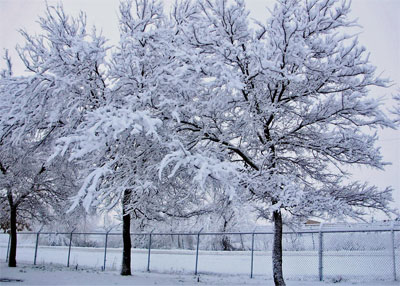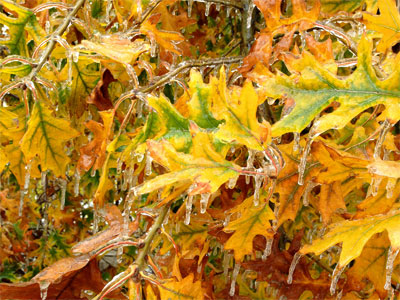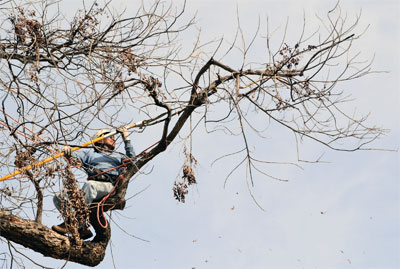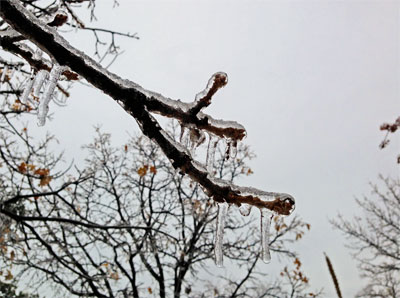A Certified Arborist’s View on the Storm

While we delight in the sight of snow-covered trees, too much of a good thing can lead to severe damage. Photo by Steve Houser.
by Steve Houser
Snow and Ice Damage to Trees
It is the time of year when all good arborists start to worry about ice and snow damage to our trees. The weather events of the past week justify those concerns. Often times, we are so excited to actually get a little snow, we overlook the potential damage that can occur. The dramatic change of a little snow is welcome, until it just keeps coming down. Joy quickly turns to fear as your live oak snaps a limb — and it falls on your favorite holly. If you were a tree, your biggest concern beyond the effects of humans, would be the effects of Mother Nature.

Deciduous trees that have not dropped their leaves have a difficult time supporting the weight of ice and snow accumulations and are likely to suffer broken limbs. Photo by Bill Seaman.
If your landscape has only deciduous trees, those that lose their leaves, you may think you have no worries. However, the recent ice storm tells us otherwise. Enough ice can build up on limbs without foliage to cause breakage. A half-inch of ice on a limb will dramatically increase the weight load on limbs, trunks, and roots, leading to structural failure.
Although we had great fall color and warm fall weather, the mild weather slowed the drop of the leaves. As a result, trees that did not lose their leaves had more surface area for the ice or snow buildup, increasing the odds of breakage. The same situation applies to some deciduous trees, such as Texas red oak and blackjack oak, which go dormant but may tend to hold their leaves all winter. Although the tree is dormant, it is much more susceptible to damage.
Sleet, following cold rain, is also a problem because the sleet sticks to wet limbs and foliage, causing the rain to freeze. If you already have snow buildup on limbs and leaves, the sleet adds to the weight.
The best defense against ice and snow damage is to work diligently now to minimize any future impact. Extremely severe weather can cause the loss of most, if not all, trees in an area, regardless of any efforts to reduce the damage before it occurs. Damage from less severe weather can be lessened by inspecting trees for weak branching habit that is likely to fail. In some cases, weak areas can be reinforced with cables or bracing rods. Ideally, poor branching structures — tight V-shaped forks or attachments, should be removed when the tree is small. Doing so eliminates the risk of that fork splitting as the tree matures.

For trees with spreading canopies, selective end-weight reduction pruning can significantly reduce damage from heavy snows and ice. Photo by Bill Seaman.
Beyond resolving weak branching habit, be aware that longer limbs in trees that tend to have broad, spreading canopies, should have the end-weight reduced to lessen the surface area exposed to ice, snow, sleet, or high winds. Professional tree climbers are trained to climb out to the ends of the limbs to reduce the weight.

Bur oak trees have stout limbs and a branching habit that supports the load of ice and snow with minimal damage. Photo by Bill Seaman.
Arborists also consider the strength of the wood for each species of tree when determining corrective actions for structural deficiencies. An oak will typically have strong wood, whereas a maple will be weaker-wooded and more likely to break.
Ice, sleet, and snow buildup can cause tree limbs to bow to a great degree without breaking. The affected branches will return to their previous position once the ice and snow melts. In some situations, however, the limb can contain internal cracks that are difficult to see, or the vascular system may be damaged to the point that the limb permanently retains a bent shape.
Once you have an ice or snow problem, little can be done until the weight load melts. Low limbs on larger trees or smaller ornamental trees can sometimes be braced with wood or other materials. However, doing so can put someone at great risk should the tree or limb fail during the process of propping it up.
Once the severe weather event is over, standard tree care practices should resume. This includes removing broken and damaged limbs by making proper pruning cuts, evaluating any splits or cracks in trunks or branches, inspecting and adjusting any cables or bracing rods on mature trees, and adjusting staking hardware on newly planted trees.
The snow and ice can be beautiful, but when it comes to the risk it may present to your trees, the adage “Be careful what you wish for” applies.
